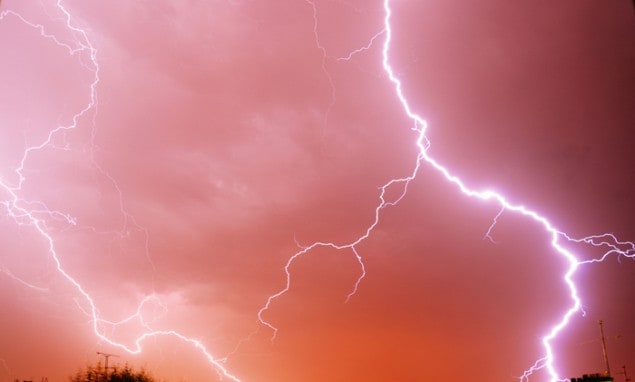
The discovery of a link between fast solar-wind streams and lightning could improve forecasting of hazardous weather. Scientists from the University of Reading in the UK have found that the arrival of high-speed solar-wind streams at the Earth boosts lightning rates for around 40 days.
“Very energetic particles known as galactic cosmic rays, generated by distant supernova explosions, have long been thought to influence the electrical properties of the air as they fall into our atmosphere, triggering lightning,” team member Chris Scott explains. “What we have done is to show that energetic particles generated locally in the solar wind can also influence the electrical properties of our atmosphere, despite being much lower in energy.”
Lightning forms in convective clouds that have become charged. Although the energetic particles in fast solar winds do not create the conditions necessary for lightning, Scott explains, they appear to boost the rate or magnitude of lightning that transports charge between the cloud and the ground.
Advance warning
“Since the energetic particles in our study are associated with high-speed solar-wind streams rotating with the Sun, we know that such streams will wash past the Earth roughly every 27 days,” says Scott. “This gives us a potentially useful method of forecasting the severity of storms some weeks in advance.”
The team found that just before the arrival of high-speed solar streams, the total solar irradiance drops, and increases occur in sunspot number and Mg II emissions – the latter being a spectroscopic measurement that is related to solar activity. This is consistent with the source of the stream being on the Eastern solar limb and rotating at the 27-day period of the Sun, the researchers say. The arrival of the solar-wind stream on Earth also coincided with a 1% drop in galactic cosmic-ray flux and a 6% increase in lower-energy solar-energetic protons at tropospheric altitudes.
To carry out the study, Scott and colleagues used solar-wind data for 2000–2005 from NASA’s Advanced Composition Explorer spacecraft. Lightning data, meanwhile, came from the UK Met Office’s Arrival Time Difference system, which employs radio receivers across Western Europe to detect “sferics”, which are broadband radio emissions associated with lightning. Timing the arrival of sferics at different stations can locate lightning over the UK with an accuracy of 5 km.
Focus on central England
To keep their measurements uniform, the researchers studied lightning that took place within 500 km of central England. They also employed records of thunderstorm activity from observing sites across the UK.
After 2005, the Arrival Time Difference system was expanded to form ATDnet, which can detect smaller sferics. The number of lightning strikes increased by an order of magnitude and the solar-wind effects were no longer apparent. The researchers believe this may be because, prior to 2005, the fast solar wind increased the magnitude of individual lightning strikes above the system’s detection threshold, thus creating the appearance of a rise in the rate of lightning.
“While we have shown that lightning rates can be altered by solar-wind conditions, we have a lot of work to do in investigating the exact mechanism by which this process takes place, and the magnitude and global extent of this effect,” says Scott. “Our study concentrated on lightning over Europe.”
Scott and colleagues reported their findings in Environmental Research Letters (ERL).
- This article first appeared on environmentalresearchweb
- There is much more about the physics of lightning in this feature-length interview with Joseph Dwyer of the University of Florida: “The physicist who tames lightning”



